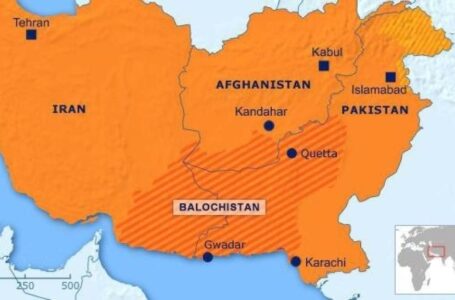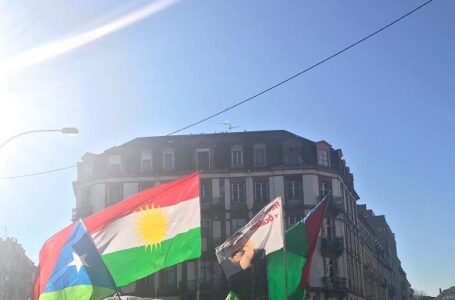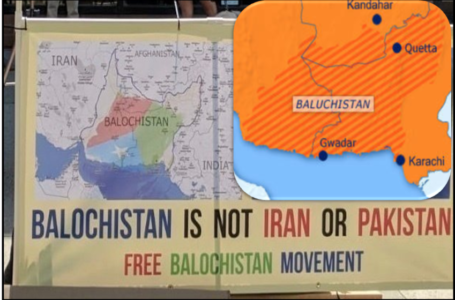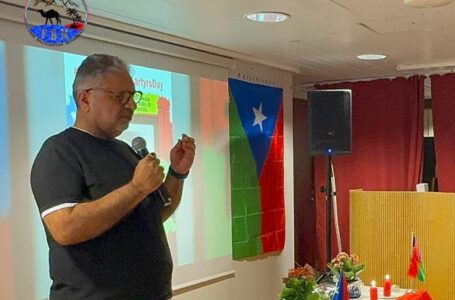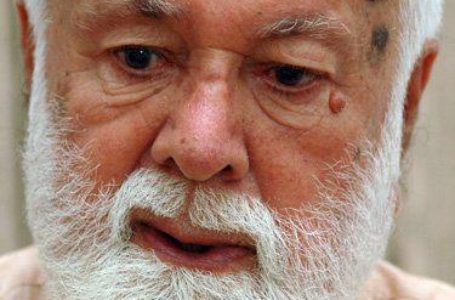Israel’s decisive Attack on Iran a Significant Opportunity for Baloch National Independence: FBM
Swings in US-Pak relations
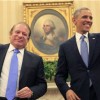
The United States generally, and the U.S. State Department in particular, seem perennially unwilling to grasp the realities of Pakistan. Refusing to recognize that Pakistan pursues ideological goals through the use of terrorism under its ever-expanding nuclear umbrella, the United States persists with the same strategy it has always used to handle the “Pakistan problem” – namely, attempt to induce better Pakistani comportment through handsome allurements.
The most Panglossian American policy makers believe that there is some magical combination of rewards and engagement that, over some time horizon, will transform Pakistan from the regional menace it is today, into a state that is at peace with itself and its neighbours. The most pusillanimous of policy-making poltroons fret that should the United States curb its generosity and demand that Pakistan honour its varied commitments like any other responsible state, Pakistan may fail and the Islamist barbarians will knock down the nuclear gates with grisly consequences for humanity.
Once again, the U.S. State Department revealed that it has no intention of taking the Pakistan problem seriously. In May 2015, Foggy Bottom approved Pakistan’s request to purchase some $952 million of American military hardware which includes attack helicopters, missiles, and communications equipment. In an explanatory press release from April 6 (2015), the State Department justified this decision by arguing “ This proposed sale will contribute to the foreign policy and national security of the United States by helping to improve the security of a country vital to U.S. foreign policy and national security goals in South Asia”.
While in some sense such foreign military sales benefit the U.S. defense industry, approval of these sales evidences perjuring obfuscation of the root causes of Pakistan’s problems and abjuration of what a better course of action might be. After all, Pakistan’s problem is not a lack of capability to fight the various terrorists ensconced in its territory; rather the will to do so comprehensively. Equally important, Pakistan continues to create new militant proxies while sustaining old ones even while it attempts to fight those who have turned against the state and who cannot be bullied or bribed back into the fold of the deep state.
The time for such folly has long passed. The United States needs a more realistic policy towards Pakistan. In this essay, I argue why these decades-long policies have long failed and I put forward several propositions that should inform a new policy towards a state that is the problem from hell.
A Laundry List of Dirty Deeds
To summarize briefly, since FY 2002, the United States has provided Pakistan $7.6 billion in security-related assistance, $13.0 billion in lucrative reimbursements under the dubiously-named “Coalition Support Fund” program, and another $10.5 billion in economic assistance. This largesse was both to reward Pakistan for its putative support in the war on terrorism while incentivizing future support. Has the United States secured value for this $31 billion? Let’s recount how Pakistan has “contributed” to the war on terrorism.
Pakistan has persistently supported the Afghan Taliban, who are responsible for the deaths of 2,356 U.S. military personnel, another 677 coalition military deaths, and the deaths of thousands of civilian contractors, for whom there is no official count under U.S. reporting requirements. This is in addition to the more than 21,000 Afghan civilians who have died since 2001. The death toll of Afghan National Security Forces (ANSF) is a tightly guarded secret; however, various sources estimate that more than 20,000 Afghan police and army personnel have been killed since 2003. More than 5,000 ANSF were killed by insurgents in 2014 alone.
Without Pakistan’s direct military, diplomatic, political and financial support as well as secure sanctuaries in Pakistani territory, the Taliban would not be as lethal or capable. The Taliban might even not be viable as an insurgent movement without these vast Pakistani amenities. In addition to the Afghan Taliban under Mullah Omar, Pakistan continues to support the Jalaluddin Haqqani network, which has conducted sophisticated, deadly suicide operations at U.S., NATO and Indian facilities in Afghanistan.
This sort of behaviour has become Pakistan’s standard operating procedure. Since 1947, Pakistan has used Islamist militants in an effort to wrest Kashmir from India.
It has used Islamist militants in Afghanistan since 1974, if not earlier. Since 1990, Pakistan has introduced extremely lethal groups such as Lashkar-e-Toiba (LeT, now operating under the name of its above-ground wing Jamaat-ud-Dawa, JuD) and Jaish-e-Mohammad into the Kashmir theatre and elsewhere in India. Since 2002, according to the Global Terrorism Database at the University of Maryland, these two groups have killed more than 1,132 persons and injured more than 2,423 in about 162 attacks. Moreover, the Jaish-e-Mohammad attack on India’s parliament in December 2001 and LeT’s May 2002 attack on military families in Kaluchak nearly brought the two countries to the brink of war. LeT, finally concentrated the attention of U.S. policy makers when it conducted a multi-site attack on India’s port city of Mumbai, which culminated in a siege that lasted several days. By the time the carnage ended, ten LeT militants slaughtered 166 people including six Americans.
Of course, as all Americans know, the United States located Osama Bin Laden’s lair a short distance from the Pakistan Military Academy. So far, Pakistan has shown little interest in investigating—much less identifying and prosecuting—those persons who aided and abetted him and his protection racket. Instead, the only person Pakistan has arrested was a physician who contributed to his capture.
Yet despite this never-ending list of outrages from America’s erstwhile “partner,” Washington still finds ways of wasting the hard earned taxpayers’ dollars on this country which works strenuously to undermine U.S. interests in the region and beyond. It seems that the United States is paying Pakistan ostensibly to support the war on terrorism while Pakistan is using terrorism and American generosity to wage its proxy wars, in which many Americans have been the victims.
In the afore noted press release, the U.S. State Department argued that “This proposed sale of helicopters and weapon systems will provide Pakistan with military capabilities in support of its counterterrorism and counter-insurgency operations in South Asia.” The press release further contended that this sale will enable Pakistan to better conduct operations in North Waziristan Agency (NWA) and elsewhere by providing Pakistan with “a precision strike, enhanced survivability aircraft that it can operate at high-altitudes” and by conferring upon Pakistan the ability to operate in “all-weather, day-and-night environments.”
Such argumentation would make sense if there were any evidence that Pakistan is fighting the same war on terrorism that America is. There is no such evidence. However, what every American must understand is that Pakistan fights a highly selective war on terrorism. It has only taken up arms against those militants who have turned against the state and whom Pakistan’s military and intelligence agencies cannot bring back into the fold. These militants, most of them operating under the banner of the Tehreek-e-Taliban-e-Pakistan (TTP or “Pakistani Taliban”), have their varied roots in Pakistan’s support for Mullah Omar’s Afghan Taliban; a zoo of Islamist militants such as Jaish-e-Mohammad, which Pakistan raised to fight in India; and sectarian militants such as Lashkar-e-Jhangvi and Sipah-e-Sahaba-e-Pakistan, which Pakistan’s military and civilian leaders have cultivated at various times for domestic purposes, including the slaughter of Pakistani Shia. These militants share a Deobandi interpretative tradition as well as an archipelago of Deobandi madrassahs and mosques. They also have political support among some factions of the Deobandi Islamist political party the Jamiat-e-Ulema-Islam (JUI).
After 2002, many of the leaders of these Deobandi organizations began to question then General and President Musharraf’s decision to facilitate U.S. military operations in Afghanistan to oust the Afghan Taliban. After all, the Afghan Taliban successfully established an Islamist regime in Afghanistan consistent with their Deobandi interpretation of Islam. President Musharraf was actively conniving with the United States to bring that down. These Deobandi groups had also become close with al Qaeda, sometimes training in the same camps. As the Taliban and al Qaeda were rousted from Afghanistan and pushed into Pakistan’s tribal areas, new militant formations began to emerge.
By 2004 if not earlier, Pakistan began to experience the formation of insurgents based in the tribal areas after Pakistan began undertaking military operations there under U.S. pressure. These Deobandi militant groups began to form micro-emirates of sharia first in the tribal areas and then elsewhere in what is now known as Khyber Pakhtunkhwa.
As this insurgency developed, Pakistan’s military began facing heavy losses. Pakistan uses these losses to argue to the United States that it is just as much a victim of terror as is the United States. It pointed out years ago that its battlefield deaths vastly outnumbered those of Americans in Afghanistan. It uses these fatality figures as counterpoints to those Cassandras, such as this author, who have long decried the double game that Pakistan was and is playing in Afghanistan.
This is not to say that Pakistan is not fighting someone. For several years Pakistan has tried to persuade the Pakistani Taliban to either join the fight in Afghanistan or re-join groups that operate in India such as the revivified Jaish-e-Mohammad. In fact, the ISI, Pakistan’s premiere intelligence organization, denervated this Deobandi group precisely for this reason. Those who took the offer were re-baptized into the deep state and their murderous sins forgiven. Those who demurred are the targets of these various offensives which have killed far more innocent civilians than the drone program and have displaced millions from their homes.
In 2009, the Obama administration acquiesced to the demands of his generals in Afghanistan and authorized the “surge.” The surge was never about battlefield effects because the small numbers of the surge could never deliver such effects. After all, if one took Field Manual 3-24 on counterinsurgency seriously (and I did not), you would need about 450, 000-500,000 troops in Afghanistan. We never had more than 140,000. Moreover, the surge misdiagnosed the problem. We were—and are—losing in Afghanistan in large measure due both to industrial strength corruption and malfeasance in the Afghan government and to the enduring sanctuary and other amenities that Pakistan affords the Taliban. To win in Afghanistan—by any metric of winning—the international community had to foster better business practices amongst themselves and amongst their Afghan partners. And it had to put serious pressure on Pakistan to kick the Taliban habit. It did neither.
Instead, the surge made the United States more dependent upon Pakistan for ground lines of control (GLOCs) than ever before while doing little to develop genuine alternatives. The Northern Distribution Route could never carry more than 20% of the logistical demands and Russia insisted that it not be used for lethal goods. And since this is about supplying a war, that restriction was important. And even though the United States was perfectly capable of working with Pakistan despite a well-known history of horizontal and vertical nuclear proliferation and decades of supporting terrorism, neither the United States nor its NATO partners could find a way of working with Iran’s private sector to resupply the war.
After all Iran, with Indian help, built a deep water port in Chabahar and India and Iran collaborated to connect that port to the Ring Road in Afghanistan. Even though Iran had more in common with the United States when it comes to Afghanistan and Pakistan, the United States overlooked Pakistan’s nuclear proliferation and terrorism penchant while failing to see any virtue in the Iran option. This was unfortunate because in the early months of the war, Iran supported the United States bilaterally and in bilateral fora. Had Washington capitalized upon this Iran opening rather than proclaiming it to be a founding member of the Axis of Evil, it may have had a chance of “winning” in Afghanistan.
In the end, the United States made itself more vulnerable to Pakistani predations at a time when it needed to pressure Pakistan heavily if it wanted to ensure an Afghan future with little likelihood of a non-elected Taliban presence.
A Way Forward
Cynics in South Asia and beyond contend that the U.S. decision to keep arming Pakistan to kill terrorists while it continues to make terrorists is a collusion of convenience. The U.S. arms industry gets a buyer and Pakistan continues to make itself relevant, and thus eligible for continued assistance, in a war on terror of its making. It’s a self-licking ice cream cone. Frondeurs will further gripe that the United States also desires to sell arms to India. This seems to put the United States in the dubious position of benefiting from an arms race that it encourages. Generally, I rubbish these arguments. However, many in Pakistan and in India accept these canards as reality. This perception undermines legitimate American efforts to engage both countries. More importantly when the United States justifies such sales to Pakistan as being inherently in U.S. interests, the United States looks explicitly foolish or complicit in such games.
Washington needs to take advantage of its declining dependence upon Pakistan to support its presence in Afghanistan and forge a very different means of engaging Pakistan. I am not suggesting that the United States cut off ties to Pakistan and stop all programmatic activities. Instead, I am arguing that the United States treat Pakistan like any other state and hold it accountable for its actions. Any “special engagement” with Pakistan must be under very strict guidelines that explicitly and genuinely advance U.S. interests.
At a minimum, U.S. security assistance generally and defense sales of strategic systems and any platforms that materially increase Pakistan’s warfighting capabilities in particular should be predicated on three conditions. First, Pakistan must recognize the line of control in Kashmir as the legitimate border. After all, the zoo of terrorists that Pakistan has assembled to prosecute its proxy war in Kashmir has precisely contributed to the internal security challenges for which Pakistan now wishes to purchase these helicopters and hellfire missiles. Moreover, nothing will stop Pakistan from using these in India or against ethnic insurgents in Balochistan. Arming Pakistan to kill some terrorists while it continues to nurture others makes little strategic sense. The United States should most certainly continue to train Pakistani military personnel in the United States and other forms of engagement and assistance that will help Pakistan buttress its internal security capabilities. But it should demur from materially adding to Pakistan’s military capabilities vis-à-vis India while it remains committed to territorial revisionism through the use of terrorists and nuclear coercion.
It should be noted that Pakistan has no legal claims to the portion of Kashmir under Indian administration. Pakistanis who point to U.N.S.R. 47 of 1948 to argue that it does should read the text of the resolution to disabuse themselves of this fantasy. To this end, the United States should stop recognizing the line of control as a disputed border and use its influence within the United Nations to secure support for this position. Doing so will deprive Pakistan of the political justification for its reliance upon the menagerie of terrorists it has reared to wrest Kashmir from India. By removing Pakistan from the equation, the United States can more usefully engage India quietly to redress the myriad problems it has with its own Kashmiri citizens. Equally important, the United States should encourage Pakistan behind closed doors to integrate those Kashmiris under its own administration.
Second, any such sales of weaponry should be contingent upon Pakistan not only ceasing support for the various terrorists it has nurtured but actively de-mobilizing them. This will be a long process. However it makes no sense for the United States to provide arms to Pakistan to fight terrorists when confederate terrorists undertake operations in India, which is the most likely precipitant of the next war between India and Pakistan.
Third, Pakistan wants to be respected as a legitimate nuclear power. Yet Pakistan has proven itself to be a reckless nuclear power boldly boasting of developing tactical nuclear weapons to contend with Indian doctrinal evolution. The United States should seriously consider curtailing provision of conventional military capabilities as long as Pakistan pursues these nuclear capabilities. After all, the logic of these tactical nuclear weapons is not to defend Pakistan against Indian aggression. Rather, they are meant to deter an Indian military response to a terrorist outrage in India committed by a Pakistani proxy.
In addition, the United States should allow the IMF and other multi-lateral funding agencies to hold Pakistan accountable for its past and deliberate failures to make the economic reforms it promised to make as a condition for the various “bailouts” it has received. Excessive bilateral and multilateral bailouts allow Pakistan to abscond from making the necessary tax reforms which form the ballast of a true democracy. These bailouts also lubricate any friction that arises between those who want a more genuine democracy and those that are satisfied with the current deep state. Tax reform is a necessary but insufficient condition for the development of democracy in Pakistan and a first step towards renormalizing civilian-military relations.
Critics of such a way forward will argue that the United States will “lose influence” in Pakistan. My response to this assertion is that I see little evidence of such “influence.” Since 9/11, Pakistan has expanded its nuclear arsenal and redoubled its commitment to terrorism. If this is influence, I’m happy to forego it.
In the end, such a realistic policy towards Pakistan may not result in a Pakistan that behaves better in the policy-relevant future. However such a policy will at least spare the American public the continued indignity of subsidizing Pakistan’s most dangerous policies, several of which account for thousands of dead Americans and many more injured in the Afghan war.
*C. Christine Fair The writer is the author of Fighting to the End: The Pakistan Army’s Way of War
Courtesy: Asian Tribune


